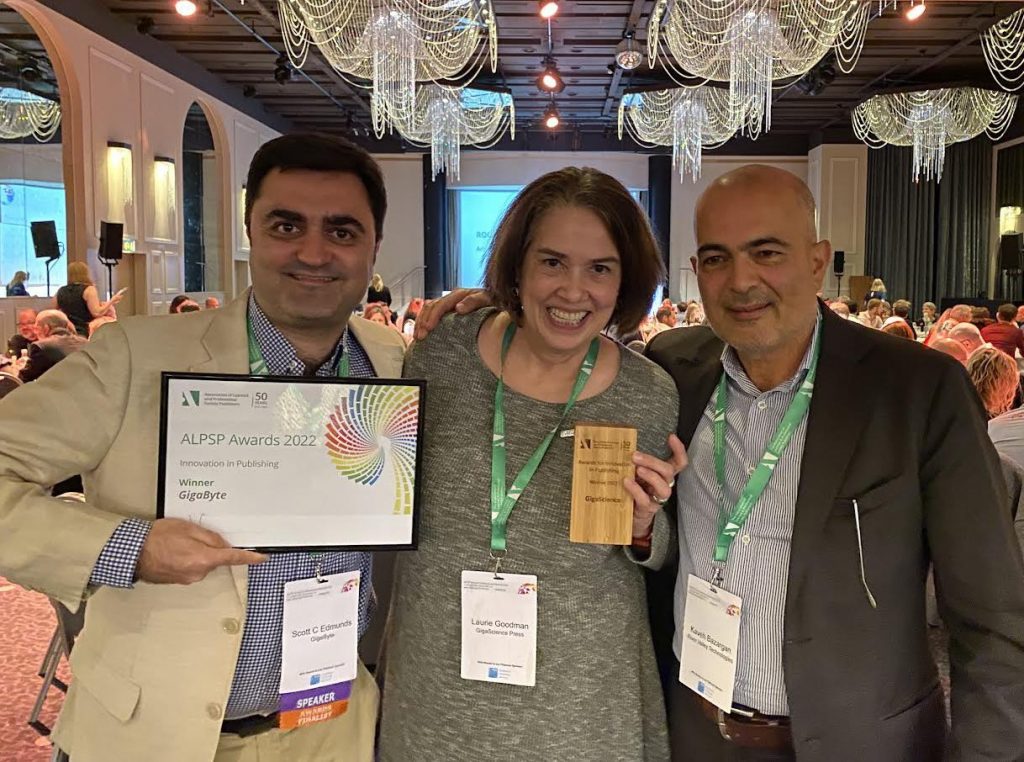Celebrating and innovating: This was 2022 at GigaScience Press
It was a year to remember, for more than one reason: 2022 marked the 10th anniversary of GigaScience‘s launch. The journal’s younger sibling GigaByte got an award and continued to innovate with living documents and its first trilingual article. And we published lots of memorable research, featuring, for example, a giant tortoise and 26 deadly snakes. Before some of the editorial team take a short break to celebrate Christmas and New Year, let’s have a look back.
To mark the occasion of our two-digit birthday, we threw a GigaScience party at the ISMB meeting – no, not via Zoom this time. Finally, after the long COVID disruption, we could celebrate in a real-world pub, sharing panda-themed birthday cake and drinks with conference participants in Madison.

The milestone birthday was also an opportunity to look back at what we have achieved in our first ten years, and we wrote that up in the form of an editorial. To briefly recap, during our first decade of publishing we step by step pushed for ever more open science and open data. We created our own data repository GigaDB, managed by a team of curators and integrated in the publication process. We embraced the FAIR principles, promoted preprints and implemented mandatory open peer review. Together with other platforms, we experimented with various tool integrations.
GigaByte pushed boundaries and got an award
With GigaScience‘s data-centric sister GigaByte, and together with our partner RiverValley Technologies, we are taking this even further. Articles can now be “living documents“, we introduced “update” articles, a simplified review process using check lists, and recently even published a trilingual article: readers can easily switch between English, Spanish and Ukrainian versions.
Our efforts to innovate have been noted in the publishing world. In October, GigaByte and RiverValley received the ALPSP Innovation in Publishing Award, recognizing our efforts to push the boundaries in academic publishing.

Almost 10 years after GigaScience was launched, UNESCO in 2022 published its Open Science Recommendations to “foster a culture of Open Science and aligning incentives for Open Science”. This is a significant document, because it shows that Open Science practices – advocated by GigaScience over the last decade – are finally becoming the mainstream expectation of how research should be done all over the world.
Commentaries on a decade of progress
As a birthday gift to GigaScience readers, we also invited a series of commentaries, taking a look back a decade of progress in large-scale research. Open Science has gained momentum – as evidenced by the UNESCO recommendations – and the commentaries reflect what has been achieved and what lies ahead in the future of various fields. Topics cover, for example, conservation genetics, open and FAIR efforts in neuroinformatics, or the challenges of computational pathology.
Our data curation team (Chris Armit, Mary Ann Tuli, Christ Hunter) also contributed to this celebratory series. They report a consistent growth of our GigaDB ressource in terms of data volume, data discoverability and data re-use and discuss the role of Data Curation in enhancing the user experience.
We handed the collection of commentaries out in the form of a glamorous one-off print issue, but of course the entire series is available online and open-access, like all our content.
One of the main reasons why data should be open is to give other researchers the opportunity to re-use the information for new projects, often in completely different and surprising contexts. The “Research Parasite Awards” (jokingly named after a controversial editorial in a medical journal) recognize scientist who make outstanding contributions by using existing datasets. We were very happy to learn this year that the Junior Parasite Award went to Jack Pilgrim at Liverpool University for his work published in GigaScience (read the paper and blog).
GigaByte mobilized more than 500,000 biodiversity records
Another highlight of the past year was a series of Data Release papers on vectors of human disease, published in GigaByte in collaboration with the Global Biodiversity Information Facility (GBIF). This series of papers was supported the Special Programme for Research and Training in Tropical Diseases, hosted at the World Health Organization.
Vector-borne diseases are responsible for more than 17% of human cases of infectious diseases, but…
” … huge gaps exist in the information related to these vectors, creating an essential need for campaigns to mobilise and share data.
The publication of data papers is an effective tool for overcoming this challenge. These peer-reviewed articles provide scholarly credit for researchers whose vital work of assembling and publishing well-described, properly-formatted datasets often fails to receive appropriate recognition.” (see this article to read on)

The first set of GigaByte papers in this article collection mobilized more than 500,000 occurrence records, and 675,000 specimens from more than 50 countries. The series now goes into a second round, read the announcement here.
No summary of the year is complete without highlighting at least some of the science we published in 2021.
Highlights of GigaScience 2022: Giant tortoise, deadly snakes et al.
Recently, Gözde Çilingir and colleagues published a high-quality, chromosome scale genome sequence of the Aldabra giant tortoise. The Aldabra is one of only two giant tortoise species left in the world. Conservation efforts are underway, and high-quality genomic and genetic information will improve the chance of long-term success of these efforts. Watch the first author explaining her research, in the presence of a rather stoic live Aldabra tortoise.
Similarly, also the new genomic resources for the helmeted honeyeater, a highly endangered bird, will be crucial for genetic rescue efforts. Also the first author of this GigaScience paper, Diana Robledo-Ruiz, has produced an explainer video that you should not miss:
And with this blog post turning into a science video watch party under the Christmas tree, here’s another special one. Czech scientists Jozef Kaiser and Marketa Tesarova used X-ray computed microtomography to produce stunning 3D reconstructions of the soft tissue in the head of the proteus, a cave dwelling blind salamander. Enjoy live footage of the proteus, 3D reconstructions of soft tissue, and soothing music:
On a less soothing note, just this week the Center for Antibody Technologies headed by Professor Andreas Laustsen-Kiel presented proteomic and functional data on the venoms of 26 deadly African snakes, including fearded species such as the green and black mambas. Whereas previous studies examined usually only one or a handful of species, this new GigaScience work relied on a a high-throughput pipeline to produce the largest largest proteomics dataset on snake venoms so far.

The machines are coming
One area that is gaining more and more prominence in our inbox for new submissions is Machine Learning in all its shapes and forms – unsurprisingly. As an example how Machine Learning methodology is conquering all areas of biology, GigaScience this year published research aimed at profiling the capabilities of Machine Learning models in an immunology context – specifically, to analyse the adaptive immune receptor repertoire.
With the growing volume of machine learning papers we also continued to sharpen our criteria for this article type. Our goal is to focus on Machine Learning work that follows best practice in terms of reproducibility and transparency; this of course means sharing data and code and being transparent about all methodological aspects. In addition to the FAIR principles, which are always on our mind when assessing new submissions, we also increasingly have an eye on recommendations that are specific for the machine learning domain, such as the DOME-ML guidelines.
Gigascience and GigaByte are journals with a specific expertise in transparent and open data publishing, and we are excited to see which new applications the Machine Learning community will find for the data presented in our journals. The speed of progres in this field is breathtaking, and as I finish this blog post I start to wonder if next year I will still have to do this end-of-year job in a traditional way, sitting at a keyboard with three cups of coffee and a plate of christmas cookies. Or if an AI will draft this yearly summary in a fraction of the time, and without the need to supply copious amounts of sugar and caffeine. In science and also in science publishing the AI revolution has begun – with effects good and bad.
We thank our readers and authors for their continued interest in GigaScience and GigaByte, and most of all our reviewers and editorial board members for their tremendous support during our 10th year.
Merry Christmas , happy holidays, and happy new year!
